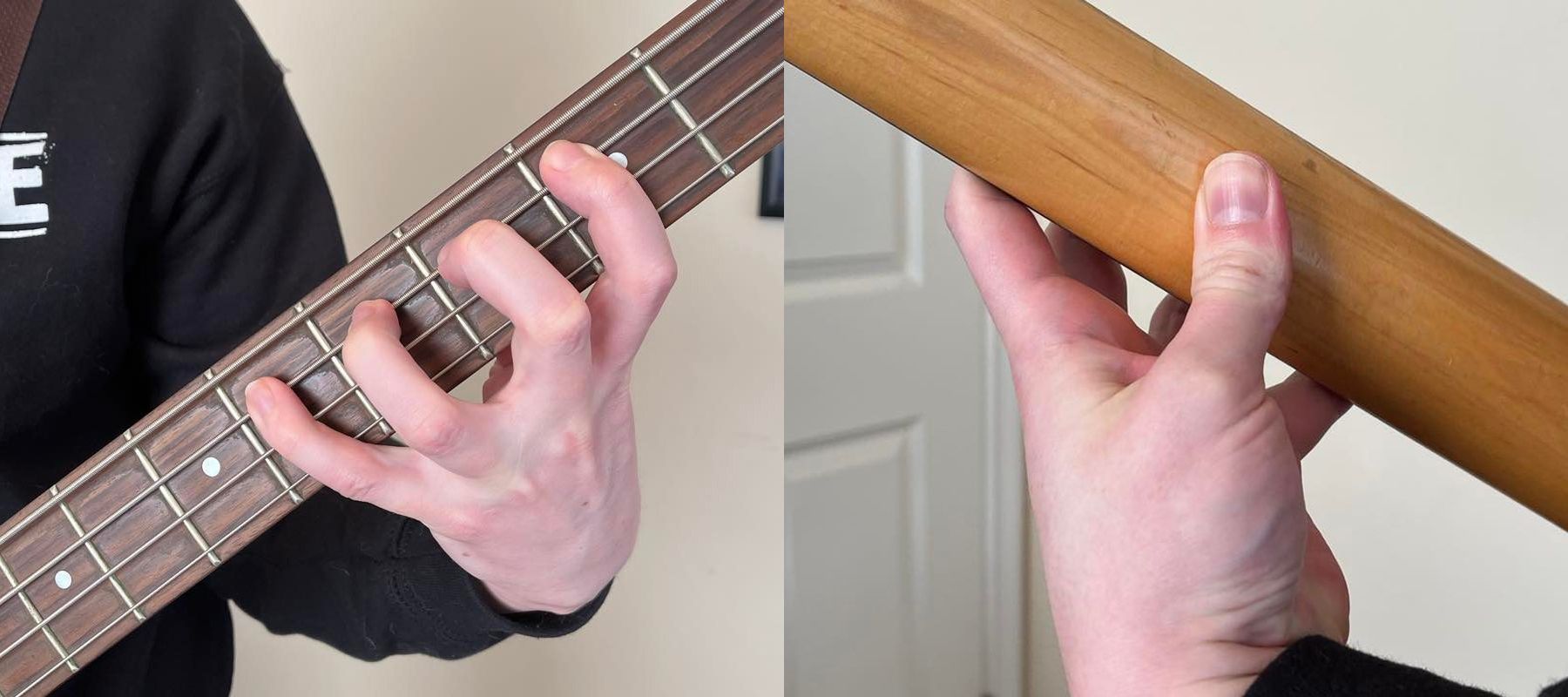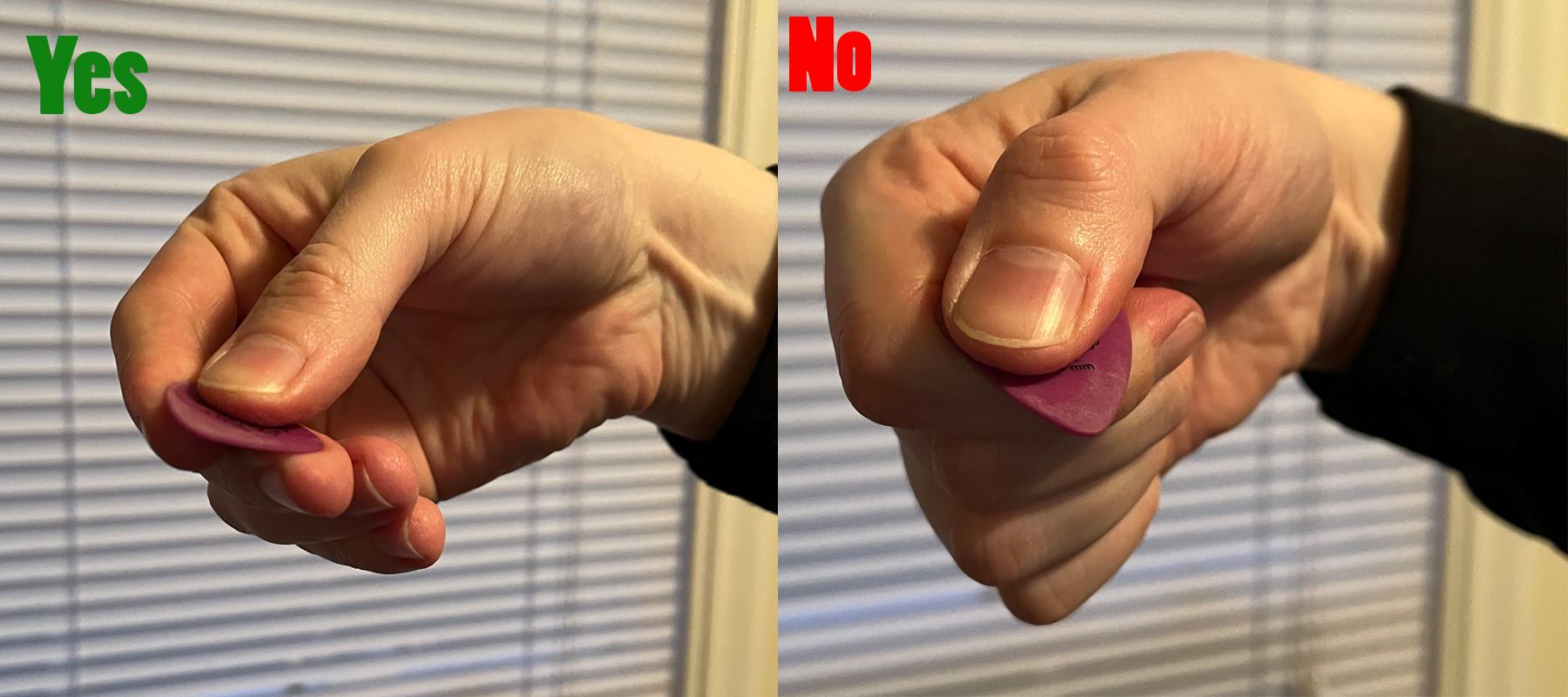

 Thumbnail
Thumbnail
Hell Yeah, you do. Bass guitar is cool. You get to have all the fun in the band with significantly less responsibility than everyone else. But really, In my opinion, Bass is a great fundamental instrument to have under your belt when it comes to understanding music theory and songwriting. This first lesson, we’re going to go through some basics of technique and music theory, and get you started on being the bass player in a cool band.
Side note, This article is mainly coming from a Punk and Hardcore background. I did play in jazz band all through high school, but this is not exactly that. We’ll be focusing on the skills and knowledge you need to get started in bands.
So, you pick up this big piece of wood and metal, What’s the best way to hold it? Basically, you’ve got 2 hands to worry about: Your “fretting hand”, and your “Picking Hand”. We could talk about finger style, but we’re playing the hard shit here, use a pick.
Fretting Hand: The most important thing, is that your thumb should be placed firmly on the back center of the neck of your bass. Your fingers should be splayed out, and you should be able to reach every string, with one finger per fret. We’ll call this “The 4 fret block” (This will come up later). This will provide even pressure on all frets with all of your fingers. Think of it kind of like you’re trying to pinch each of your fingers to your thumb. While you do see some bass players do it, it’s generally a bad Idea to let your thumb hang over the fretboard. When starting out, this doesn’t give your fingers enough strength to really get notes sounding good. Start with good technique, and when you want to lower your bass and start looking like you’re Tim Armstrong, you’ll know how the right way is supposed to feel.
 Fretting Hand
Fretting Hand
Picking Hand: You’ll want to play with heavy guitar picks. I prefer the purple Dunlop’s, sometime the greens do fine too. Anything around 1mm or thicker. To pick, you’ll want to hold the pick between your thumb, and index and middle finger. You might be tempted to hold the pick between the side of your index finger and your thumb, but I would advise against this starting out. This makes you want to pick with your wrist, and to keep from injuring yourself, you’ll want to play bass with more of your wrist and forearm. This will help you hit notes harder, and not develop carpel-tunnel later in life. You’ll also be able to play faster down the line.
 How To Hold a Pick
How To Hold a Pick
Exercises: Play the 4 fret block on all 4 strings, with open strings, on frets one through 4, up and down again. If looking at Tabs, it’ll look something like this:
$E 0 1 2 3 4 | $A 0 1 2 3 4 | $D 0 1 2 3 4 | $G 0 1 2 3 4 |
$G 4 3 2 1 0 | $D 4 3 2 1 0 | $A 4 3 2 1 0 | $E 4 3 2 1 0 ||Don’t worry if those numbers don’t mean anything to you yet, we’ll talk about them in a bit. Just come back to this exercise when you practice, if you forget which notes are which.
Alright, so you know how to hold your bass. But how do you know what you’re playing? It’s time to talk about some basic music theory, and how it applies to your bass.
In western music, we quantize our tones into 12 notes, and we use the letters A through G to represent them. I can hear you say now, “But that’s only 7 letters! I thought there were 12 notes?” Well, the system is kindof dumb to be honest, but it’s a convention we’ve been using for a very long time. Basically, certain notes have what we would like to call “Sharps”, or “Flats”. In most cases, these represent what are called “half steps” in between notes. A sharp is a half step up, and a flat is a half step down. You can notate things in either direction, and you would technically be correct. For reference in music notation, we notate sharps as “#” and flats as “b”. Every note written as sharps would be:
A -> A# -> B -> C -> C# -> D -> D# -> E -> F -> F# -> G -> G#
As flats, they would be:
A -> Bb -> B -> C -> Db -> D -> Db -> E -> F -> Gb -> G -> Ab
So you can see, A# and Bb are the same note. We have both notations for use in scales, but we’ll get to that later. Also, you might notice that there is no half step between E and F, or between B and C. I would guess the reason for this has to do with the C Major Scale and how pianos are made, but that’s just a guess, and I think it more has to do with the system just kind of being quirky and weird. That’s pretty much all you need to understand for this portion though.
So, the strings on a standard tuned bass are : E, A, D, and G. Where E is your lowest / thickest string, and G is your highest / thinnest string.
To make sure your bass is in tune, the easiest way to do this is to start with your A string, and hold down the 5th fret. (The second one with a dot on it, from your headstock). Your 5th fret here will be the same note as your D string, so you can turn your D tuning peg until these two notes sound the same. This works for every string, where the 5th fret is the same as the next string up. This method will get you in tune with yourself, but not necessarily with the world around you. Invest in a tuner pedal if you’d like that luxury.
As you might have guessed, each fret is a half step up from the previous on our note chart we made above. So, if you start at E (in flat notation), The first fret on the E string is F, then Gb, then G, then Ab, then A, and so on. On the A string, we have Bb, then B, then C, then Db, and then D. I’m sure you can sus out the other two strings.
What this does for us, is that this means we don’t really have to go past the 5th fret unless we’re playing something really high up on the neck if we don’t want to. Or, we can use the 4 fret block we learned earlier, and place that anywhere on the neck, and get to pretty much all of the notes that we need. Guitar players have to take neck placement into consideration for Chords, but we are bass players, and can’t be bothered with playing more than one note at a time. This is really useful for playing things quickly, since we don’t really need to be sliding all over the neck all of the time. We can just stay mostly in one spot, and move our fretting fingers up and down the strings.
So, now you know where most of the notes you’ll be playing are, but how do you actually use that information? What order should you put notes in to write a song? How do you know it’ll sound good? This is where these things called “Scales” come in. Basically, a scale is an order of notes that sounds a certain way. Most traditional scales hit every note, some don’t. We’ll be focusing on 3 scales today, because all of HC and punk basically runs on 3 scales. A scale can be thought of as a collection of “intervals”, or half steps and whole steps. When looking at our note chart above, a “half step” is when you move from one note to a note right next to it. So, moving from C to Db, or E to F. A whole step, is moving 2 notes away in our chart, like D to E, or G# to A#. The first scale we’ll focus on today is the Major scale. Most people call this a “happy” sounding scale, where the pattern is: whole –> whole –> half –> whole –> whole –> whole –> half -> half. C major is the easiest of the major scales to understand, because it’s just every note that doesn’t have a sharp or a flat attached to it(C->D->E_>F->G->A->B->C). You can take this pattern, and apply it to any note as your first note, and the scale will sound more or less the same. So while the D# major scale will sound tonally different that the C major scale, it will still have the same feel.
One way to get these under your fingers, is to understand the pattern in our 4 fret block. if we go up a string every time we hit our pinky (fret 4), then we can think of the major scale as “2 -> 4 -> 1-> 2 ->4->1->3->4”. You can place this anywhere on the neck, and you’ll be playing that major scale.
The C Major Scale:
$A 3 5 $D 2 3 5 $G 2 4 5 ||So, how do we use these to write songs? Well, basically, you just take the notes in a scale that you like the sound of, and just pick which ever ones you like in an order that you think sounds good. Major scales are what literally every pop-punk song ever has been written in. Just pick out a few random notes from this scale, and play them over and over again, and you’ve got your standard Blink 182 song.
Every other traditional scale (or mode, if we want to be technical) is derived from this major scale. It’s just a matter of what note you’re starting on in this major formation. And when you hear music nerds talking about the “major 4th”, or the “minor 3rd”, they’re talking about the numbered note in that Root notes scale. So, the major 3rd of C is E, since E is the third Note in the major scale. An “Octave” is just the same note as the root when you loop back around ( low C to high C, vice versa). If you understand this concept, congratulations, you understand probably about 50% of music theory.
Correct. You’ve got to start somewhere, but I would agree. The second scale you should keep under your belt is a blues scale. This one is a little bit cooler sounding than most traditional scales, and is mainly used in Blues and Jazz, 70’s heavy metal, etc. Black Sabbath loves this scale. The steps are: whole+half(3 frets) -> whole -> half -> half -> whole+half(3 frets) -> whole In our 4 fret block, we can think of it as: “1->4->1->2->3->1->3”
$A 3 6 $D 3 4 5 $G 3 5Play that backwards, and it’s the end of the solo from Iron Man. This scale is used heavily by bands like Rotting out, Righteous Jams, Mental, Gel, etc. Just pick some random notes, play them over and over again, and you’ve got a song. If you want to check Rotting Out’s Laugh Now, Die Later, The whole thing is just a couple notes out of the A blues scale. They do go one note outside of the scale, but once you know these rules, you can also know when it sounds good to break them.
Which leads us to our final scale:
I’m not sure if this is technically a scale, but we can call it that if we want. The Chromatic scale is our 4 fret block, it’s all half steps. Whenever you hear someone saying something is “Chromatic”, or “Atonal”, this is what they mean. Bands like (old)Ceremony, Trash Talk, Iron Lung, really fast HC bands love this scale. Note that are right next together often sound a bit chaotic and harsh, so that’s what you go with. At the end of the day, knowing all this theory is useful, but It doesn’t always take the place of things sounding good. If going outside of a scale sounds better than staying in one, do it.
But, practicing and having these things under your fingers will make you a better bass player in the long run.
That’s pretty much it for this week! Next post we’ll be getting into the specifics of how a few different songs work in terms of theory. But for now, practice these scales and exercises, do a little bit of writing and exploring, and make sure your technique is good.
Thanks for reading and attending, and best of luck on your journey into playing bass.
Next lesson we’ll be going over: Nothin but a beatdown - Bulldoze Glass Palace - Losin it